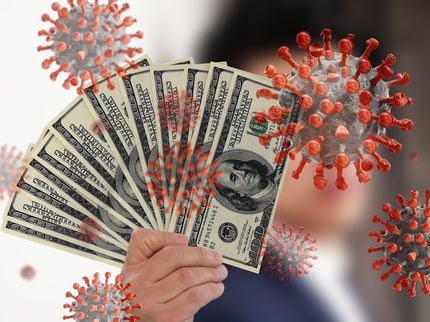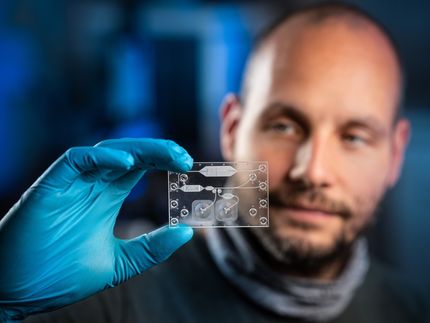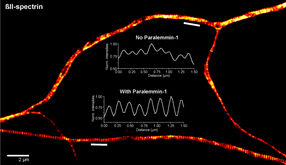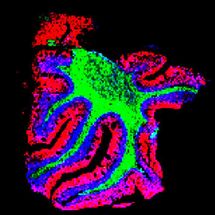Light on – light off: the test result is ready
Inspired by nature - Light-controlled bio-based OptoAssays can diagnose diseases more easily and cost-effectively
From Velcro to solar cells, many technological innovations have been inspired by nature. In medical diagnostics, researchers also draw inspiration from biological principles. A research team from the University of Freiburg and the INM – Leibniz Institute for New Materials in Saarbrücken has developed testing methods in which simple LEDs could replace complex mechanical pumps. These OptoAssays not only mimic the behaviour of biological cells but also use their genetic programming.
We have all become familiar with them since the COVID-19 pandemic: the small cassettes with discolouring paper that provide us with an answer – positive or negative – within minutes. In a SARS-CoV-2 rapid test, they indicate whether a specific protein of the coronaviruses is present in the sample liquid, the reagent, or not. A pregnancy test works in a similar way. Here, the presence of the hormone hCG causes the test line to colour. In both cases, a lateral flow assay is used, a test in which the sideways flow of the reagent leads to a result being displayed. This single unidirectional movement of the liquid on the paper is created purely by capillary forces, without any mechanical or electrical assistance.
For more complex tests, this detection method is not suitable. Here, assays are required that allow for bidirectional control of liquids, meaning the transport into and out of the test system. Unfortunately, these multi-step assays rely on expensive and wear-prone pumps. These pumps repeatedly flush out the unbound molecules from the system, ensuring that only the particles to be detected remain attached to the detection antibodies.
Researchers from the University of Freiburg and the INM have found a solution to enable complex test designs without the need for expensive and bulky equipment. In the latest issue of the journal Science Advances, they present biological assays in which expensive and complex mechanical pumps have been replaced by simple and cheap light-emitting diodes (LEDs). These OptoAssays allow for the bidirectional, light-induced movement of biomolecules and the reading of test results without the need for additional mechanical washing steps.
Light on – light off: the test result is ready.
An OptoAssay uses a sender and a receiver area, which are brought into contact by adding the test reagent. In the sender area, there is a special protein that reacts to light. This protein can either bind or release specific molecules, depending on the type of light it captures. When an LED emits red light at a wavelength of 660 nanometres, the molecules bind to the protein. Upon switching to far-red light with a wavelength of 740 nanometres, the molecules detach from the protein. In the receiver area, there are antibodies specifically designed to recognise and capture the target protein in the test reagent.
The researchers drew inspiration for this method from nature, specifically from how plants respond to light. Every cell has a nucleus where its genetic code is stored. The DNA contains the cell’s “program,” which instructs the cell what to do. To activate or deactivate this program, certain proteins must move into and out of the nucleus. Prof. Wilfried Weber, synthetic biologist and Scientific Director of the INM, explains the mechanism: “In the cytoplasm, the area surrounding the nucleus, there is a photoreceptor that can be controlled by light. When it receives red light, it becomes activated and attaches to a binding protein. This binding protein then transports the photoreceptor along with it into the nucleus, where it might trigger, for example, a growth program. Once the wavelength of light switches to far-red, this binding is interrupted again.”
However, the connection to nature is not just through the method itself. The photoreceptors in the OptoAssay, which release the reagents, are made from natural materials, in contrast to the pumps typically used in the OptoAssay. Genes containing the information for the photoreceptor in plant cells are extracted from the plant and inserted into bacteria. These bacteria then produce the photoreceptor and the binding protein, which are used in the OptoAssay. As a result, the originally mechanical components are replaced by naturally sustainable materials.
The researchers see great potential for the use of OptoAssays in point-of-care diagnostics, meaning outside of the laboratory, similar to lateral flow assays. Dr. Can Dincer from the University of Freiburg explains: “OptoAssays can easily be controlled and read using smartphones and could, in the future, make external flow control systems such as pumps and signal-reading devices unnecessary. So, they pave the way for new diagnostic tools that enable cost-effective and straightforward analyses directly on-site, even in resource-limited settings.”
Original publication
See the theme worlds for related content
Topic world Diagnostics
Diagnostics is at the heart of modern medicine and forms a crucial interface between research and patient care in the biotech and pharmaceutical industries. It not only enables early detection and monitoring of disease, but also plays a central role in individualized medicine by enabling targeted therapies based on an individual's genetic and molecular signature.

Topic world Diagnostics
Diagnostics is at the heart of modern medicine and forms a crucial interface between research and patient care in the biotech and pharmaceutical industries. It not only enables early detection and monitoring of disease, but also plays a central role in individualized medicine by enabling targeted therapies based on an individual's genetic and molecular signature.




























































